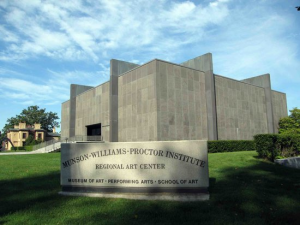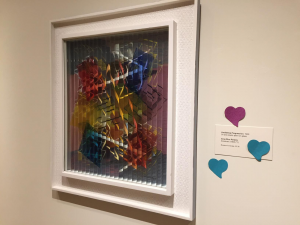by Natalie Kelsey
Some of my earliest cultural heritage-related memories are of the Munson Williams Proctor Arts Institute in Utica, NY. My father, an artist himself, brought me there as often as I wanted. The first piece I remember is also the first piece you can see upon entering the museum, Jackson Pollock’s Number 2, 1949. I remember first running up to the painting, looking closely at the expressive lines, then standing back to notice the abstract figures that, to me, appeared to be dancing across the canvas. Upstairs, I was further taken by another of MWPAI’s permanent installations – The Voyage of Life, a series of paintings by Thomas Cole. The paintings’ detailed landscapes left me in awe. Although I have chosen to pursue a career in the historical portion of cultural heritage, this particular museum remains close to my heart. For this reason, I decided to catch up with the museum in this profile of the museum’s social media presence on Twitter. MWPAI’s Twitter page appears to reach a relatively small number of people, with just over 2,000 followers. But the account is very active – posting at least two or three times a day.
 Upon visiting MWPAI’s Twitter page, I noticed that the museum and its related art education program have grown a lot since I left the area in 2010. Founded in 1919, the museum is named for its founding families, who built the foundation of the museum’s collections. The museum building itself is a work of art, designed by world famous architect Philip Johnson. MWPAI has three main divisions. The Museum of Art is the main portion of MWPAI, boasting several permanent exhibitions as well as gallery space for new artists. The Performing Arts Division presents musical performances, plays, cinema, family programs, and concerts. Finally, the School of Art offers an accredited college program as well as community arts programs for adults, teens, and kids.
Upon visiting MWPAI’s Twitter page, I noticed that the museum and its related art education program have grown a lot since I left the area in 2010. Founded in 1919, the museum is named for its founding families, who built the foundation of the museum’s collections. The museum building itself is a work of art, designed by world famous architect Philip Johnson. MWPAI has three main divisions. The Museum of Art is the main portion of MWPAI, boasting several permanent exhibitions as well as gallery space for new artists. The Performing Arts Division presents musical performances, plays, cinema, family programs, and concerts. Finally, the School of Art offers an accredited college program as well as community arts programs for adults, teens, and kids.
In 1999, MWPAI partnered with the Pratt Institute of Art and Design to offer this higher education program. This partnership is ongoing, but in 2013, MWPAI began its first Artist in Residence program. This program features heavily on the Twitter page, which showcases residency openings, resident artists’ works, and residents’ exhibitions. Also featured on the page are practical information, like changes to the museum’s normal hours, and advertising for the museum’s many community education classes. These classes include lessons in figure drawing, sculpting, jewelry-making, and animation. The page links out to the registration for these classes. Also linked are job postings and news stories, like this one, where the museum’s newest curator discusses the importance of placing art in historical context. Although there are many of these posts, they garner few responses from users.
MWPAI’s Twitter page also includes information about events at the museum,  of which there are many! There’s a First Friday Happy Hour, musical performances, a film series, and many seasonal and holiday-related programs. These are where users interact most with the page. In a post where patrons were encouraged to place heart-shaped sticky-notes next to their favorite works of art for Valentine’s Day, several users commented, excited to see their notes on the Twitter page. Another very popular program is “Museum Match,” where a selected portrait is posted on social media and patrons are encouraged to come to the museum wearing matching clothing and pose for pictures with the portrait. The museum posts some of these, and others who can’t make it to the museum post their own “Museum Match” pictures from wherever they are.
of which there are many! There’s a First Friday Happy Hour, musical performances, a film series, and many seasonal and holiday-related programs. These are where users interact most with the page. In a post where patrons were encouraged to place heart-shaped sticky-notes next to their favorite works of art for Valentine’s Day, several users commented, excited to see their notes on the Twitter page. Another very popular program is “Museum Match,” where a selected portrait is posted on social media and patrons are encouraged to come to the museum wearing matching clothing and pose for pictures with the portrait. The museum posts some of these, and others who can’t make it to the museum post their own “Museum Match” pictures from wherever they are.
The Twitter page also serves as a place where the different departments of MWPAI can interact with each other publicly. These interactions are mainly used to promote the museum’s events, but also to show museum patrons the intricate workings of the museum. Because MWPAI has grown so much and undertakes so many projects, it’s helpful and interesting to see the way the different departments interact with each other on social media.
Although it has been many years since I’ve visited Munson Williams Proctor Arts Institute in person, I feel that the Twitter page gave me a good understanding of its many current projects. The museum has grown and changed, but I can see that its goals and values remain the same as when I first ran up to Pollock’s Number 2, 1949.
